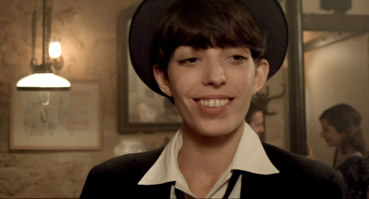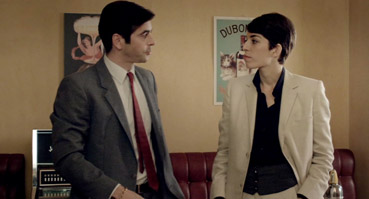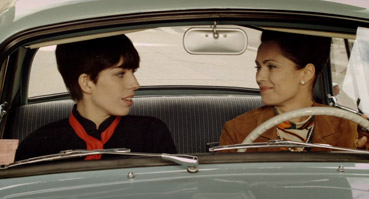|
You may not be aware of the word garçonne. I certainly wasn't. It's feminine take on garçon, the French word for boy, one whose nearest English equivalent is the oft misused "tomboy". The term was first coined in the 1880s, but found popularity in the 1930s to describe women who dressed like men, wore monocles and short hair, smoked cigars and were attracted to more feminine women. If this sounds at all familiar then there's a good chance you've seen Cabaret, whose Kit Kat Klub is peppered with these delectable creatures.
Author Laure Charpentier was herself part of the Parisian garçonne scene in the 1960s, by when the meeting place of choice for those so inclined was the Chez Moune cabaret bar on the rue de Pigalle. She later wrote a book based on her experiences, which was published in 1972 and apparently the subject long-standing censorship (I've found it surprisingly hard to track down details on this). The film adaptation was a long time coming and was first due to go into production in 2008, with Tin Drum director Volker Schlondorff at the helm and a cast that included Asia Argento, Philippe Torreton, Marisa Paredes, Ute Lemper and Marisa Berenson.* For reasons unknown, the deal fell through, but the project was picked up by Charpentier herself, who despite never having made a film before, chose to (or perhaps was persuaded to) direct it herself.

The film's central character is teenage schoolgirl George, who is in a reciprocal love affair with her teacher Sybil, one that three years later comes to an abrupt end when Sybil takes her own life. Possibly as a consequence, George abandons her degree in psychiatry and a year later has reinvented herself as Gigola, a female gigolo of some repute based at the famed Chez Moune, where she specialises in wealthy middle-aged women in search of female companionship and sexual adventure.
This briskly economical setup headlines a character portrait that evocatively recreates this almost underground quarter of early 60s Paris, one whose existence is quietly tolerated and frequented only by those in search of the specialised entertainments it offers. It's a world in which Gigola is not just at home but effectively rules the roost, having her pick of the patrons and even selecting and grooming young garçonnes of her own.
What unfolds is a series of encounters that are rarely developed in anything approaching a substantial manner. The professional relationship between Gigola and her wealthy and elderly client Odette (Marisa Paredes), for example, is not explored in any detail and is more about establishing Gigola's short-term financial security, while the prime purpose of her involvement with gangster Mr. Tony (Eduardo Noriega) is to set up a later mob hit and a sexual encounter that will impact on her future. This in some ways plays as a string of false starts, potentially intriguing story threads that recede into the background to be revived only when needed to move Gigola from A to B. This even extends to her relationship with her perpetually cash-strapped father, who returns home only to beg more gambling money from his still devoted wife.

What just about keeps these disparate and underdeveloped story threads together is Gigola herself. A captivating collision of male and female, her distinctively feminine features, boyish crop, clipped emotions, masculine dress sense and confident gait make her a focus of respect in the world in which she operates and completely sell her appeal to women of any age or social status. Such is her position that even when with a client she gets to call the shots, refusing to undress and delivering a sexual service in almost mechanical fashion and with barely controlled distaste. It's a charismatic performance from Lou Doillon (daughter of director Jacques Doillon and actress Jane Birkin), whose striking looks are never swamped by her surface masculinity. So convincing and complete is the image she creates that if you re-watch the start when her hair is longer and her appearance more feminine, it's genuinely hard to picture her as Gigola.
Whether this is enough to carry the film's stuttered narrative is open to debate. As a subjective portrait of Gigola herself (she does give her name to the title, after all) there is a logic to this structure, with the secondary characters only appearing when their stories cross over with that of our leading lady. But even these have been pared down to a selection of key encounters, and I was left with a sense that I might have formed a closer bond with our intriguing leading lady had they been more fully developed and their impact on the emotional well-being of the title character explored in more depth.
A clean, detailed 1.85:1 anamorphic transfer that copes reasonably well with the earthy colour scheme, one that increasingly feels almost de rigueur for modern period dramas. The intensity of the effect can vary depending on the location, time of day and mood of the scene – at its strongest it borders on duotone sepia, but is rather attractively graded on exterior shots. The contrast is well balanced, though some fine detail is lost to retain the beefy black levels when the light levels are low.

There's a choice between Dolby 2.0 stereo and Dolby 5.1 surround, both in the original French. Both are clear with distinct frontal separation, and the 5.1 is a more subtle mix than the stereo, but surround it is not – there is nothing at all going on at the back of the room. A bigger problem with the 5.1 track is that some of the sound effects are clearly out of sync with the picture, sometimes by as much as a second. This is blatantly obvious on two later gunshots, while the sound of a drink being poured in a subsequent scene is repeated, the second of which bring things back into sync. Such glitches are rare and are confined to certain sound effects and the 5.1 track – there are no such issues with the Dolby 2.0 track or the dialogue on either.
The Theatrical Trailer (1:12) gives a flavour of the content if not the mood and pace, and is rather curiously located in the Setup menu.
The sleeve notes, which appear to be written entirely by Laure Charpentier, are a very worthwhile read, and include a concise history of the term Garçonnes.
There are also ten trailers for other Peccadillo releases, positioned both before and after the feature (don't worry, they can be skipped if you so choose), and also accessible through the main menu.
I'm still in two minds about Gigola, whose enigmatic title character just about allows the film to ride out its underdeveloped plot strands and a music score that, while likely appropriate to the period and location, does feel a just tad cheesy in places. But the film and particularly its leading lady have certainly stayed with me, so much so that I've modelled the look of my character in the video game Saints Row the Third directly on her. Peccadillo's DVD sports a solid transfer, and while a little short of extra features, particularly given the autobiographical nature of the story and setting, the sleeve notes are most welcome.
* http://www.variety.com/article/VR1117985992
|